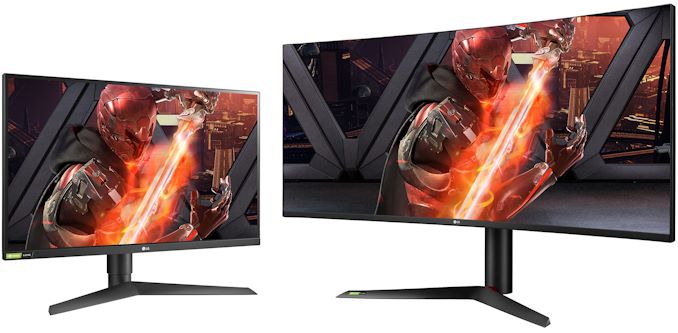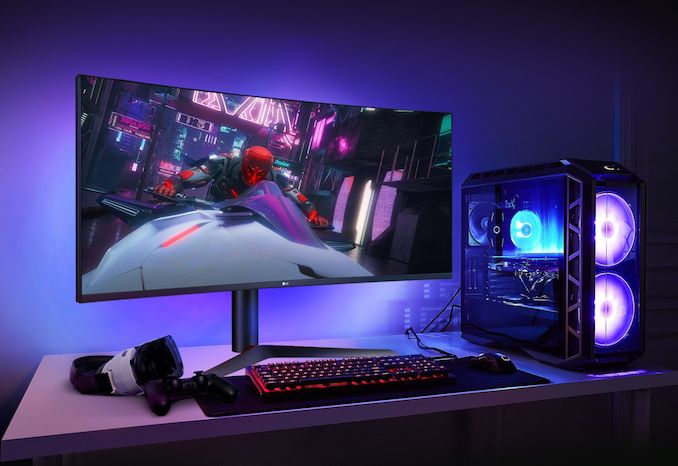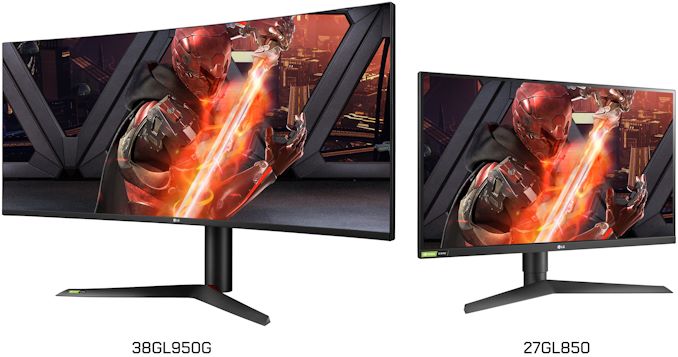LG Unveils 27 and 37.5-Inch IPS Monitors with 1 ms Response Time
by Anton Shilov on June 13, 2019 5:00 PM EST
LG has introduced the industry’s first IPS displays featuring a 1 ms response time. The new UltraGear monitors bring together high image quality that LG’s Nano IPS panels are known for, the DCI-P3 color gamut, high performance, and NVIDIA G-Sync support. Aimed primarily at gamers, the new UltraGear monitors will come in 27-inch and 37.5-inch sizes.
The smaller monitor is the LG UltraGear 27GL850 that uses a 27-inch IPS panel featuring a 2560×1440 (16:9) resolution, 350 nits brightness, a 144 Hz refresh rate, and 1 ms GtG response time. The larger display is the UltraGear 38GL950G based on a 37.5-inch panel offering a wider aspect ratio 3840×1600 (21.5:9) resolution, 450 nits brightness, a 175 Hz refresh rate (when overclocked), and also a 1 ms response time. The smaller monitor supports HDR10, whereas the bigger one is DisplayHDR 400 certified.
Both UltraGear 27GL850 and UltraGear 38GL950G LCDs can display 1.07 billion colors and cover 98% of the DCI-P3 color gamut, a very good result for gaming-grade monitors. The two displays also feature LG’s Nano IPS panels featuring a special nanoparticle cover applied to the screen’s LED backlighting to fine-tune its spectral output to absorb surplus light wavelengths and increase intensity, purity, as well as the accuracy of the on-screen colors.
Since LG’s UltraGear displays are designed primarily for gamers, both support a number of features aimed at this audience. Apart from NVIDIA’s G-Sync dynamic refresh rate technology, the new LCDs also support LG’s Dynamic Action Sync mode, Black Stabilizer, and Crosshair functions. Besides, the larger display supports LG’s Sphere Lighting 2.0 technology.
As far as connectivity is concerned, both LG’s UltraGear 27GL850 and UltraGear 38GL950G monitors feature DisplayPort and HDMI inputs, as well as a dual-port USB 3.0 hub. Meanwhile, they have neither a headphone jack nor integrated speakers.
| The LG UltraGear-Series Displays | |||
| 27GL850 | 38GL950G | ||
| Panel | 27" IPS | 37.5" IPS | |
| Native Resolution | 2560 × 1440 (16:9) |
3840 × 1600 (21.5:9) |
|
| Refresh Rate | 144 Hz | Native: ? Hz Overclocked: 175 Hz |
|
| Dynamic Refresh Rate | Technology | NVIDIA G-Sync compatible | NVIDIA G-Sync |
| Range | ? | ? | |
| Response Time | 1 ms (gray-to-gray) | ||
| Brightness | 350 cd/m² | 450 cd/m² | |
| Contrast | ? | ||
| Color Gamut | 125% sRGB 98% DCI-P3 |
||
| Viewing Angles | 178°/178° horizontal/vertical (?) | ||
| Curvature | none | curved | |
| Inputs | 1 × DisplayPort 1.2 2 × HDMI 2.0 |
1 × DisplayPort 1.2 1 × HDMI 2.0 |
|
| USB Hub | 2 × USB 3.0 Type-A | 2 × USB 3.0 Type-A | |
| Audio | none | ||
| Proprietary Enhancements | Dynamic Action Sync mode, Black Stabilizer, Crosshair |
||
| Stand | Height | ? | |
| Tilt | ? | ? | |
| Swivel | ? | ? | |
| Power Consumption | Idle | ? | |
| Typical | ? | ||
| Maximum | ? | ||
LG plans to start sales of the UltraGear 27GL850 display in the third quarter with pre-orders in the US starting on July 1, 2019. LG does not disclose pricing of either UltraGear 27GL850 or UltraGear 38GL950G monitors, but without any doubts both will belong to the company’s premium family of products.
Related Reading:
- LG Unveils UltraGear 34GK950 34-Inch Curved Gaming Displays with Nano-IPS
- LG to Demo UltraWide 38-Inch 144Hz Gaming & 49-Inch Workstation Displays at CES
- LG Launches Midrange 32UL750-W Monitor: DisplayHDR 600 with FreeSync & USB-C For $750
Source: LG












49 Comments
View All Comments
mode_13h - Saturday, June 15, 2019 - link
Obviously. But, it seemed like you were only proposing 24:10 because it simplified the numerator, in this particular case. As awkward as it is to use 9 everywhere, at least it eases the task of comparing them. IMO, that's the main priority.I would much prefer to go decimal than switch everything to a denominator of 10. Then, we can do away with the silly W:H notation, as well.
piroroadkill - Friday, June 14, 2019 - link
Ratios as fractions should, in reality, be reduced to the nearest integer, so your example should be 12:5.Then again, I'm no fan of any of this, I prefer the 1.6:1, 1.77:1 format. Forget integers, and just make the width a proportion of a fixed (1) height.
mode_13h - Saturday, June 15, 2019 - link
> Ratios as fractions should, in reality, be reduced to the nearest integer, so your example should be 12:5Well, if you don't constrain the denominator, then you can have a policy of finding the nearest integral fraction. However, you're forgetting that these specs need to be easily comparable. So, what appeals to your mathematical sensibilities is actually consumer-unfriendly.
> I prefer the 1.6:1, 1.77:1 format.
If you use a denominator of 1, then just drop the silly W:H format. It's redundant and not obvious to neophytes.
mode_13h - Saturday, June 15, 2019 - link
> the nearest integral fractionUh, I should've just said "the nearest ratio of integers".
Jeff72 - Thursday, June 13, 2019 - link
So what's a good 30" or higher 16:10 monitor these days?shabby - Thursday, June 13, 2019 - link
hp zr30w :)mlkmade - Thursday, June 13, 2019 - link
Been waiting for this monitor since it was announced at CES. Finally 1600p with high refresh rates!Dunno why Anandetch has so many of the specs blank when they're already listed on LG's official product page. 144hz is the native refresh rate for the 38"
mobutu - Friday, June 14, 2019 - link
maybe now TN's will die, seeing that one of their only two advantages vanishes: response time.only the price advantage remains, as they are still cheaper.
halcyon - Friday, June 14, 2019 - link
No real HDR, no FALD, no G-Sync HDR no HDMi 2.1, not UHD/4K, not true 10-bit (it is 8-bit + FRC) AND a $2000 USD asking price?Really LG, you are not going to sell a lot of these with those three true HDR G-Sync HDR 200Hz monitors coming down the pipeline from Asus, Acer and AOC.
imaheadcase - Friday, June 14, 2019 - link
Well you are wrong, Asus, Acer and AOC announced those monitors..2 YEARS ago now. Besides not many people care about HDR at all, it really is just a silly thing. Why even bother with HDMI? Its a gaming monitor..you are insane if you think anyone would push a 4k past the 144Hz it offers, let alone on the 38inch one.